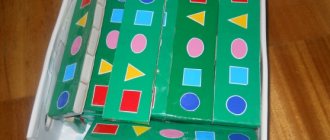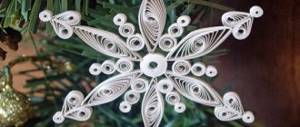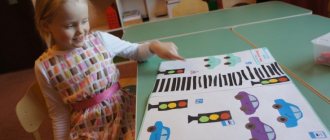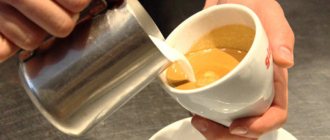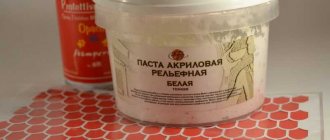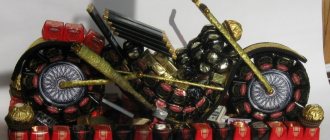Master class on creating a painting from amber chips. The material presented requires minimal pictorial skill and extreme accuracy. Materials: tempera paints, natural amber, PVA glue.
Preparation.
The basis of the future picture is unusual - an even one and a half centimeter cut of a birch trunk. Let's depict a landscape on it, and, of course, a birch tree. To make the picture “in scale”, let’s create the atmosphere of a sunset.
We sand the base with sandpaper and outline the contour drawing of the composition. The drawing can be done both before and after gluing. This is not important. Since the goal of creating a work of high art is not pursued, we will take the plot from photographs and “synthesize” it on the board.
Gluing is the simplest: a weak solution of PVA glue with water.
The illustration shows a section with a pencil outline drawing applied to it without any "cool" geometric constructions. Two things are important to us: to maintain a certain rhythm and to convey the characteristic features of birch. Please note that by drawing “some” mythical plant and painting it with white paint, you do not convey the character of the birch. How to draw a birch trunk? Go outside and examine a living tree to visually identify its characteristic features: the trunk is usually straight and has the shape of a highly elongated cone; the branches first go up, and then smoothly bend down, like a stretched bow.
Painting
When doing underpainting, try to make it look picturesque. Try to put as much color into the miniature as possible.
We use tempera glue or oil paints. Watercolor and gouache will not work, because we will be gluing the golden amber onto PVA. Water-based paints can bleed, and accidental splashes of glue can leave stains.
We do the first underpainting fluidly and quickly. There is no point in covering areas with thick paint. The wood will “suck in” the first layer and the color will fade. It is better to wait until the underpainting dries and forms an adhesive film. By passing the paint over it again, you can enhance the color where required.
Initially we are interested in the sky and water. We will pay less attention to other details. They will be covered with amber, so we’ll just paint them picturesquely.
We work closely with the sky and the river. We outline clouds, reflections in a water mirror, a birch trunk, going deeper and deeper into details. Let’s denote the leafy crown with “spots”. This will give the natural color of amber additional shades.
We continue painting until it is ready, without touching the wood or soil. Only at the very end will we draw in detail the birch trunk, branches, outline the grass on the ground, and for now we will stop at the details. Let's return to them at the very last moment, when the amber crumb is in its place.
Inlay with amber chips
The picture is quite small, therefore, the amber chips are needed as small as possible. In extreme cases, it is permissible to prick the pieces with wire cutters.
Amber is glued locally. There is no need to smear the entire work with glue and sprinkle crumbs on top. Use glue only where you are currently going to lay the stones. Naturally, try to follow the composition.
Don't save money. Add as much crumbs as needed, but don't overdo it. Place large pieces immediately where large areas of deciduous mass are planned. There will be a ragged outline along the edges, and gaps between the large ambers. Fill these “shortcomings” with smaller crumbs. It’s also good to “trifle” along the contour of the leafy masses. In several places, mark separately hanging leaves.
Don't be afraid to stain amber with glue and don't be afraid of its angular, untidy outlines. The final step is to coat the work with varnish. The varnish eliminates all imperfections and adds a precious shine.
There is no point in trying to glue stones at once. It is better, having sketched out the main compositional areas, to leave the picture until tomorrow in order to evaluate it with a “fresh” look.
When you notice that there is enough amber, stop and evaluate the picture as a whole. Perhaps some details need to be finalized, additionally tinted, some clouds need to be added, some volume added to the tree, a few very thin branches.
Above is a photo of the finished amber painting after varnishing. No additional finishing is required, neither is the frame. Their function will be performed by the picturesque bark.
Natural stone with inclusions of rare insects costs several thousand dollars per 1 kg. Therefore, craftsmen are interested in how to make amber: such jewelry can be sold at a profit.
Piece handmade work in the era of machine labor is also highly valued, as are the creations of nature itself.
BUSINESS IDEA
Making artificial amber is a marginal option for organizing a profitable business.
What can be made from amber
Amber is a very beautiful stone with different types of colors: pale yellow, lemon yellow, red-brown, blue, even black or green.
The structure of natural stone is heterogeneous: with various bubbles, inclusions, transparency and translucency.
Amber is used to create all kinds of bracelets, pendants, rings, pendants, boxes, paintings or figurines.
Amber, what is it?
To make your own amber painting successful, you should study a little of the properties of the main material of the painting - amber. So, amber is centuries-old resin from coniferous trees that has turned into stone. This is a fairly soft stone, it can be easily cut and polished. Today it is used for jewelry, as well as for creating amber paintings. Note that this is a durable and incredibly beautiful material for creating paintings.
Amber - a sun stone with an insect inside
How to make amber at home
Sometimes a natural mineral is also added to the mixture.
Let us consider in detail the technology for manufacturing artificial stone.
What ingredients will you need?
To create artificial stone at home, the following components are required:
- 1 part resin (polyester, epoxy, turpentine);
- 1 part white rosin;
- shellac;
- gelatin.
To achieve greater plausibility, wood chips, insects and dye are added to the finished composition.
It is important to consider: the amount of rosin and resin must be equal.
Preparing the form
You can make artificial amber with your own hands in several ways:
- pour the prepared mass into molds to obtain the necessary parameters of this material;
- obtain the desired figure by pressing.
Step-by-step instruction
The production of artificial stone consists of the following stages.
Method #1:
- Mix the resin and gelatin in a ratio of 9:1 well and pour into the mold.
- Add 2 drops of room temperature water to the mixture and mix gently using a thin wooden stick.
- Place in a well-ventilated area and leave for 24 hours.
- Then you can begin processing the resulting product.
Method #2:
- Melt resin - 1 part in a tin pan and add shellac to it - 2 parts. After the mass reaches translucency, add rosin - 1 part.
- Boil the mixture until completely transparent. The increase in transparency of the material depends on the duration of the cooking process.
- Pour into molds and leave until completely cool.
Process of further processing of the product:
- The first stage of processing is peeling. It consists of removing the crust, which is formed as a result of weathering, using coarse sandpaper.
- The next stage is leveling the product, which has a rough appearance with noticeable chips or scratches. For this step you will need medium-grain sandpaper.
- Next, you need to grind and polish the artificial amber. For this purpose, stock up on fine-grained sandpaper and felt (felt, flannel).
As a rule, cutting, faceting and additional polishing of artificial amber are also carried out.
The combination of these measures allows you to achieve the desired material shape, thickness and size.
The same applies to tumbling - a technique used to obtain a large number of amber beads of various shapes. This process involves processing small pieces of artificial amber in a drum.
Text author: Natalya GLEBOVA
Specialist in mineralogy.
Graduated from St. Petersburg Mining University. I have a large collection of various stones and can tell you about the unusual properties of minerals. Please rate the article and share with your friends! Write comments - I will definitely answer!
Amber is one of the most unusual natural stones, with an interesting history of origin and healing properties. Despite the beauty and warm color of amber stones, jewelry work with them is considered difficult, since due to their fragility the raw material can be easily crumbled or damaged. Taking into account all these nuances, ready-made jewelry and products are expensive, so many fans of the mineral create crafts from amber on their own, resorting to simple methods and available materials. At home, you can create a beautiful pendant, necklace, or even a whole picture from amber chips, if you have patience and natural raw materials.
Subtleties when assembling finished amber products
Drilling holes
Often, when making amber jewelry at home, it is necessary to drill holes in the stone. This must be done before polishing, because otherwise the workpiece may slip out of your hands at the most crucial moment. Drilling the hole is carried out at low speeds, the diameter of the drill should be no more than 1 mm. At the same time, every 2mm the drill must be cleaned of adhering chips. If you want to make a through hole, it is better to drill it alternately from different sides of the stone to avoid chipping.
Gluing parts
It happens that a product consists of several parts that need to be glued together. It is very easy to do this at home. In order to glue the amber pieces to each other, you need to lubricate both parts with adhesive, heat and press firmly. For gluing parts, a celluloid solution, a 50% solution of sodium or potassium alkali, or a solution of copal in ether can be used.
Increased transparency
If you are not satisfied with the transparency of the stones, it can be increased. In order to make amber more transparent at home, it can be boiled in linseed oil. Make sure that the heating and cooling of the oil is gradual. The second way to increase transparency is to ignite amber at temperatures above 100 °C. When the product cools, sparkles will form inside it, and the surface of the stone will acquire a reddish tone.
One of the largest pieces of amber
Galtovka
To get a variety of amber beads of various shapes at home, you can use a very simple processing method. Its only drawback is that it will take a lot of time. So, tumbling is the process of rolling small amber pieces in a drum . Pour amber crumbs with abrasive powder into the drum and moisten thoroughly with water. Gradually it will be necessary to change the abrasive, replacing it with a finer one. As a result, after a long tumbling process, you will get a lot of smooth and shiny beads that would be too difficult to process by hand due to their size.
How to make imitation amber
Exquisite pendants, sun necklaces and beautiful decorative elements are just a small list of what can be made from amber at home. The only thing you need for this is pieces of natural stone. However, the search for natural, high-quality raw materials most often causes difficulties for people trying to create some unusual thing.
If you can’t stock up on real stone, don’t be upset. You can make an imitation of amber yourself by purchasing the following materials:
- polyester resin;
- hardener;
- soft molds;
- clean water at room temperature.
- 90% resin and 10% hardener in a container and mix thoroughly with a wooden stick.
- If desired, you can add a few drops of water to the resulting mixture to form a pattern and bubbles inside the stone, dye or wood chips for greater beauty. This will give the finished simulation realism.
- The thick resinous mass is poured into molds pre-lubricated with vegetable oil. Leave for exactly 24 hours to harden.
- A day later, the resulting “amber stones” are carefully removed from the molds, wiped off any remaining oil and polished with sandpaper.
This method is good for preparing material used for small decorations and paintings from amber chips.
If you plan to use a large piece of amber as a decorative item or as a large stone for a pendant, you can build an imitation with a frozen insect inside. This method is more labor-intensive and requires the purchase of the following materials:
- pieces of plywood;
- composition for the preparation of polyester resin;
- dye of the desired shade;
- MDF block;
- protective gloves;
- composition for preparing silicone;
- scotch;
- dried insect, such as a butterfly or mosquito;
- cling film;
- sandpaper;
- sharpened tools for shaping stone.
- First, a mold for the future stone is prepared. Take an MDF block of the required size. A box is constructed from pieces of plywood, the walls of which are firmly fixed with tape. MDF is placed inside the box, glued for reliability. To prevent the silicone from sticking to the wood, the block is wrapped in cling film.
- After this, prepare the silicone according to the instructions and pour the resulting mixture into the box. The product is left for 24 hours until completely dry.
- Using a measuring cup, measure the volume of the mold to calculate the required amount of polyester resin. The resin is prepared according to the manufacturer's instructions, and a dye is added.
- The resulting resin mass is divided into two equal parts. The first part is carefully poured into the mold to prevent bubbles from forming inside the stone.
- The resin is left alone for an hour to thicken, then the pre-dried insect is sent into it. The second part of the resin mass is poured into the mold from above and the workpiece is left until completely dry.
- The hard and dried workpiece is removed from the box and shaped using sharp tools, then sanded with sandpaper. After finishing with grinding, the finished stone is polished.
LiveInternetLiveInternet
Quote from Katra_I
Read in full In your quotation book or community!
Imitation of amber
Information from the site https://fantastikmakosh.ru/
Wonderful jewelry, isn't it? But it's just epoxy resin. And... a little imagination. If you find time to experiment a little, you can give your loved ones a good gift: a pendant, brooch, bracelet made of homemade amber, which is not easy to distinguish from the real thing by its appearance. Materials: epoxy resin, which modelers use for gluing parts, harden it, organic glass 1.5-2 mm thick, a little glycerin, sandpaper, GOI paste.
Using a heated metal object, press the shape of your choice into the organic glass. When the glass has cooled, grease the inside of the mold with glycerin. Mix the resin with the hardener (nine parts resin and one part hardener) and pour into the mold. Now drop 2-3 drops of water there and stir a little with a thin folder in a circular motion so that the water, combined with the resin, forms a unique amber pattern. Remove the hardened product from the mold, sand it with fine sandpaper and polish it with GOI paste. You can wall up a dead insect, a blade of grass, a small leaf, or a flower petal inside homemade amber. In this case, you should not bury water. You need to pour a little resin into the bottom of the mold, let it harden slightly, then stick an insect to it and fill the mold to the brim. You need to work with resin in a ventilated area, wearing thin rubber gloves.
Home technologies for making souvenirs, crafts and decorative items from epoxy resin and polyester varnish Such souvenirs can be made as follows: Remove the mold from the sample you like, make 8-15 castings. And from them we already make the main mold, so one mold will make 8-15 castings in one pour. If you need to increase productivity, it is enough to make a few more forms. It is good to tint epoxy resin with oil paints, but before doing this it is advisable to squeeze the paint out of the tube onto an old newspaper to remove the oil from it. By adding bronze or aluminum powder to the resin, we obtain a solution of gold or silver color. You can dip the castings in alcohol stain and, after letting them dry a little, wipe them with a cloth soaked in nitro solvent. In this case, the convex areas will be lighter and the recesses will be darker. To provide additional strength in the manufacture of haberdashery, powder fillers can be added. If the cast blanks stick to your hands, they should be immersed in water with washing powder, that is, as if to wash the product. Shop workers, as a rule, do not work with epoxy; they prefer polyester varnish because it is much cheaper and easier to find in large quantities. They work with varnish in the same way as with epoxy resin, only in addition to the hardener, an accelerator is added to it to speed up the hardening process. Since the accelerator is added 5-10 times higher than the norm, the varnish becomes very hot when hardening and may crack. To prevent this from happening, the varnish casting must be immersed in cold water in time, and then washed in warm water with washing powder. Due to the high temperature during hardening, the varnish can only be poured into sealant molds. There are products in stores that sellers say are made from artificial bone. They are actually made of polyester varnish. Also, various models of toy tanks, figurines, etc. are made in a similar way. Casting parts from epoxy resin A radio amateur designs miniature electronic devices, and he needs, for example, miniature plugs. What to do? Make it yourself, from resin. A pawn or other chess piece was lost, the handle of a gas stove was cracked, someone liked a business card with raised letters on the front doors - they can also be made by casting them from resin (Fig. 1). Using this method, you can make as many buttons as you like in a wide variety of shapes, small hangers of your own design, frames for family photographs, floats for fishing rods, figurines of soldiers, models of antique guns, cars and many other items. From the same resin, you can restore the missing metal elements of antique furniture according to the existing model, and make them functional, and not props. Resin castings can be helpful in repairing antique, ornate frames. If there are any defects in antique furniture, and the carved decoration is partially damaged, it is also worth turning to resins that resemble wood and casting the missing parts from them. In order to start casting, you must have a model of the object being cast. It can be made from wood, plaster, wax or even plasticine. The model can also be the object that we want to copy. If you need a decorative metal element for furniture or another figurine of a soldier, we take a sample and use it to make a mold for casting. You must act as follows. A cardboard box, metal or plastic jar must be lined inside with aluminum foil, in which chickens are usually baked, pressed against the walls of the dish and smoothed on the bottom. And now a rather funny, but necessary procedure: the model, that is, the regulator knob or any other object, a copy of which needs to be made, should be thoroughly lubricated with shoe polish (you need to use a good cream with a high wax content). After the cream has dried, the model should be cleaned with a soft brush so as not to rub off the wax and to obtain a smooth, even surface. The wax should isolate the model from the resin. When using plasticine, the model must be glued to the foil at the bottom of the dish and filled with resin mixed with a hardener. In order not to waste a lot of resin, you need to add a filler to it - the easiest way is dry flour. There should not be too much filler so that the resin does not form a paste. The resin should be fluid and easily fill the mold - for this it can be diluted a little with acetone or nitro solvent. When the resin hardens, remove everything together with the foil from the container. Then remove the plasticine and clean the model from it. Apply the cream again to the model and the bolt, as well as to the surface of the mold. Cover everything with foil and fill it with resin again. This way you get two halves of the mold with the model inside. After the mold is removed from the dish, you need to unscrew it (it is screwed together with a screw), remove the model, make a filler hole and a hole (or even more than one) to remove air. If the screw is to be secured in the handle, it should be washed thoroughly and re-lubricated with cream. Also thoroughly lubricate the inside of the mold with cream and clean it. Fold the molds and fill with resin. After the resin has hardened, the finished casting is removed from the mold, but it is not very beautiful, since its color is the same as the resin. But epoxy resins can be tinted. To get a white color, you need to add zinc white. In order for objects made from it to be durable, it is necessary to add filler to the resin. Such a filler can be, for example, aluminum powder or copper filings - the result is a very original color. You can add dust of brass or brocade, etc. By adding carbon black, the resin becomes stronger and blacker. Mica will increase electrical resistance. You can even add sand - only dry and fat-free, it should be “washed” in water with the addition of detergents, and then dried well. Flour as a filler should not be treated with skepticism - resin mixed with flour becomes hard as stone. A simple method for making keychains from epoxy resin I give you the simplest technology for making keychains and various souvenir crafts. They can be made from scraps of sheet brass on tin solder with rosin. First, a strip about 5 mm wide is cut from a sheet of metal, then pieces of the required length are bent on mandrels and placed on a pre-tinned brass sheet. To assemble such keychains and crafts, you do not need a soldering iron. Place the base plate on the iron (see Fig. 2), sprinkle it with rosin, carefully, using tweezers, arrange the elements of the craft and let the solder flow into all joints, adding it as needed. All that remains is to turn off the iron, wait until it cools down, and fill the holes of the “petals” with epoxy resin, tinted with a small amount of oil paint. After the resin has cured, the base is cut around the perimeter of the craft and polished. On the pouring side, the keychain is sanded until shiny brass ends appear, and then polished. Such simple souvenir products are always in great demand. Especially if you make such souvenirs for any memorable events, events, anniversaries. For example, memorable souvenir crafts for the city’s anniversary, Christian holidays, etc. Creative success!
Creativity lessons for beginners
Admiring the beautiful products and jewelry made of amber displayed in the windows of jewelry stores, many people do not even suspect that such beauty can be made on their own at home. To create delightful brooches, beads and even roses you will need artificial or real amber, some available materials and, of course, the desire to create.
Lucky necklace
A necklace is a stylish piece of jewelry in the form of a hoop or chain that emphasizes the length of the neck and draws attention to the chest. A homemade accessory made from real or artificial amber will give confidence to any girl and will be an excellent gift for a loved one. To make amber jewelry you will need the following materials:
- pieces of unprocessed amber of various shapes with holes inside;
- pins;
- memory wire;
- flexible silicone cable, hollow inside;
- extension chain;
- clasp;
- decorative metal beads;
- rings.
- Each piece of amber is strung onto a pin, the free edge of the pin is clamped with a tool and a small loop is made. Nibble off the free edge of the pin with pliers so that you end up with a pebble with a loop at the top. Do the same with each piece.
- All prepared amber beads are strung on the wire, threading the wire through the loops. The result should be a dense rope of amber.
- The ends of the amber rope are fixed by stringing a large metal bead on each edge.
- The flexible cable is cut into two parts, each of which is equal to the length of the free edge of the wire. The tubes are placed on the ends of the wire.
- String one small bead along the edges of the necklace, bite off the excess edge of the wire and wrap it, forming a circle. A lock is attached to the first edge, and a chain to the second. The amber necklace is ready.
Beads made of stone
Amber beads are in no way inferior in beauty to other jewelry, but their production takes less time and effort. To create amber beads you will need:
- pieces of real or artificial amber;
- strong thread;
- carbine;
- double ring.
- Beads should be strung on a double thread, fitting them tightly to each other.
- A ring is attached to one end of the thread using a knot, and a lock to the other.
- Homemade amber beads are ready.
You can diversify plain beads by adding large beads of different shades or decorative beads, alternating them with amber ones. In addition, you can take unprocessed amber - the stone looks original and has healing properties.
Weaving jewelry from stones
There are many ways to make amber jewelry at home, but the simplest and most accessible is thread weaving. To work, you only need strong hemp rope and amber pebbles with holes inside. How to weave an original amber product with your own hands:
- One bead is strung on a rope and a “tie” knot is tied. A smaller bead is placed on one end and two knots are tightened underneath it. It is important that the knots fit tightly to the beads, as if fixing them in one place.
- The next pebble is strung on both ends of the rope and again tightened with a knot. Do the same with all amber beads, alternating them in size and color. At the end, a fastener is attached to the edges of the thread.
You can weave an original piece of jewelry at home not only from amber, but also from any other natural stones, combining them with different materials, for example, leather beads, beads or miniature pendants.
How to make a painting from amber with your own hands
Amber is an amazing stone from which not only jewelry is created, but also charming interior items: boxes, figurines and paintings. If during the process of making jewelry several amber pieces remain unclaimed, you should not throw them away. You can create a wonderful picture using amber chips. This will require patience, accuracy and the following materials:
- PVA glue;
- tempera paints;
- amber crumb;
- the base is canvas, fiberboard or a section of a tree trunk.
How to cut a rose
Amber is a mysterious and amazing mineral that has a special warmth and enchanting magic. Having touched this stone once, you want to touch it again and again, which is why crafts made from amber are especially popular. Craftsmen and craftsmen carve real works of art from the solar mineral, among which amber roses stand out.
Amber is fragile, so creating an amber figurative product is complex and painstaking work.
However, even novice craftsmen can cut out a neat and beautiful rosebud. To create a stone flower, you will need the following materials:
- large piece of amber;
- abrasive wheel;
- felt circle-lens;
- various attachments for the engraver;
- hand engraver;
- sandpaper;
- polishing paste.
Amber carving
To carve a stone rose from an ordinary piece of amber, you need accuracy, perseverance and a little inspiration. Armed with the tools and mentally drawing a beautiful carved flower in your brain, you should proceed to action:
- To make it you will need a large unprocessed amber stone. It can be of any shape, since it must be cut later.
- An even circle is drawn on the amber stone so that a rounded piece can be cut out of it.
- Using tools, remove excess parts and use a cutting disc to round the stone.
- If there are small amber pieces left after work, you should not throw them away - they will be useful for creating beads or paintings with amber crumbs.
- On a round shape, draw an even circle, which is divided into 4 equal parts.
- Then draw 4 segments outside the circle, drawing a curved line from the center to the tip of the lines forming a cross.
- Using a tool, four deep cuts are made in the amber stone - the future edges of the petals.
- Using the tool, continue to work on the petals - cut one groove above the petal and two below. After this, a circle and four lines arranged in a fan are drawn on the surface of the amber stone.
- According to the borders, cut out the remaining four petals from above. Each of them should start with a small depression, gradually intensifying towards the center.
- Having finished with the second row of petals, you should proceed to the third, proceeding in a similar way.
- The finished amber rose is ground and polished using a hand engraver.
Advantages of works from
Aesthetic, stylish and attractive paintings will be appropriate in any interior - from classic to modern, modern, ethnic or high-tech. The products presented by the company are created manually from natural raw materials - which means you will become the owner of a truly exclusive item that exists in a single copy. In addition, you can always order a panel based on your own sketch or photograph, complementing it with a decorative author’s frame.
Durable, high-quality and environmentally friendly works are hung in the living room or office, as well as in the kitchen, dining room or children's room. They will decorate the room, visually expand it and make it brighter, bringing success, love, happiness, optimism and comfort into your life.
Constantly updated in accordance with customer requests. Our stores are located in most major cities of Ukraine - Kyiv, Lvov, Kharkov, Dnepr, Lutsk, Odessa and Rivne. You can also browse the online catalog and purchase the work you like, arranging convenient delivery.
“Yantar Polesie” is a group of creative, inspired people, passionate about their work, who will happily make your dreams come true by creating a magnificent picture from sunny gems!
Cheap replica or amber: how to determine
Real amber is not only incredibly beautiful, but also has healing properties, which affects its cost. Jewelry and crafts made from natural minerals are expensive, which has become the reason for making imitation stones. Sometimes unscrupulous sellers shamelessly take advantage of this, trying to sell the buyer a cheap fake at a high price.
To avoid becoming the owner of artificial amber, you should know the characteristics and basic properties of a real stone, by which it can be distinguished from a fake one:
- Hardness. If you scratch amber with your fingernail, small particles will separate from it. Such an action will not cause harm to an imitation.
- Electrostatic charge. If you vigorously rub a real mineral on wool or silk, small pieces of paper will be attracted to the stone.
- When exposed to ultraviolet rays, amber exhibits luminescent properties. A fake stone does not have this feature.
- Smell. If you heat natural amber, a pleasant pine aroma will emanate from it. The imitation has no smell.
- Reaction to alcohol. The surface of amber moistened with alcohol becomes sticky and rough. The fake stone is resistant to medical alcohols.
Jewelry and products made from amber have many fans due to the warmth that the stone emits, as well as its external beauty and healing abilities. Given the high cost of jewelry, some people choose to make their own solar mineral jewelry, creating original creations. When working with stone, you must remember that amber is fragile and requires careful handling and accuracy.


